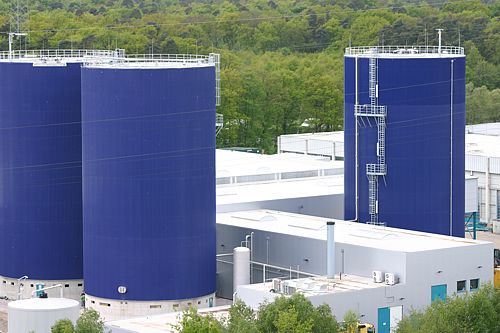As I was screening publications for the CAB Abstracts database this morning, I came across an environmentally encouraging bit of news – Anglian Water is producing enough biogas from its new advanced digestion system to deliver 980kW of energy at the engine without any further fuel requirements. The article (1) in the July 2008 issue of Water and Wastewater Treatment reported that the Anglian Water plant (Kings Lynn), where the new digesters are in operation, is currently producing about 12,000 cubic metres of biogas from about 11,000 tonnes dry solids. But how are they doing it?

An example of anaerobic digestion towers
Advanced digestion using Monsal enhanced enzymatic hydrolysis has been employed at two of their largest sites at Kings Lynn, Norfolk and Great Billing, Northants. The combined processing capacity of these plants is close to 60,000 tonnes dry solids per annum. Advanced digestion using biological hydrolysis maximises the biogas potential, which is achieved by bespoke pre-reactor design to complete the solubilisation reactions and generation of volatile fatty acids (VFAs) prior to mesophilic anaerobic digestion. High VFAs concentrations (10,000 mg/L) is produced, which is converted to biogas. The digesters convert VFAs primarily to biogas. The key innovation is the full use of the heat balance from the process in an optimal way. Low-grade heat from the combined heat and power unit is used in the first stage of the process, raising sludge temperature.
As pointed out by Rogalla (2), biosolids from wastewater treatment is an easily available source of renewable energy which is largely untapped. In view of the EU renewable directive of 2001, which requires each member state to reach an overall EU target of 12% of energy generation and 22% of electricity supply from renewable fuels by 2010, the new treatment process at Anglian Water is a good example of ways EU countries might go about achieving this target. Considering Anglian Water manages the largest geographical area of any water company in England and Wales, a lot of our waste might soon be no more a waste, but useful biofuel. Of course, the biogas produced by biomass fermentation can be a source of energy for other uses too, however, for it to be put in the national grid, it needs to be cleaned up, i.e. have poisonous gases, such as hydrogen sulphide, removed from the biogas first. I have written a book chapter on processes for cleaning biogas recently (3).
If you want to keep informed about the latest developments on biofuels, you should join the CABI Biofuels Information Exchange (http://biofuelexperts.ning.com/) for free access to over 35,000 research records on biofuels from our CAB Abstracts Database, as well as links to pertinent third party biofuels reports and books, news summaries, discussion forum and more!
References
(1) Advances in anaerobic digestion. Water & Wastewater Treatment, 51(7) 2008, pg 22-23.
(2) Rogalla, F. (2008).Turning biosolids into biogas. Water & Wastewater Treatment, 51(6), pg 51-52.
(3) Barbosa, V.L. and Stuetz, R.M. (2005). Treatment of hydrogen sulphide in biofuels. Chapter 23 in: Lens, P., Westermann, P., Haberbauer, M., Moreno, A. (eds.) Biofuels for Fuel Cells: Renewable Energy from Biomass Fermentation. IWA, London.
